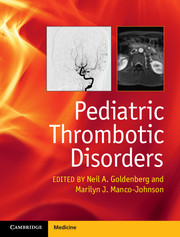Book contents
- Frontmatter
- Contents
- List of contributors
- Preface
- Acknowledgments
- Section 1 Epidemiology, etiology, diagnosis, treatment, outcomes
- Section 2 Special considerations in pediatric patients
- Chapter 8 Developmental hemostasis I
- Chapter 9 Developmental hemostasis II
- Chapter 10 Pediatric thrombophilia evaluation: Considerations for primary and secondary venous thromboembolism prevention
- Chapter 11 Role of global assays in thrombosis and thrombophilia
- Chapter 12 Heparin-induced thrombocytopenia and thrombosis syndrome in children
- Chapter 13 Severe thrombophilias
- Chapter 14 Thrombolysis
- Chapter 15 New anticoagulants in children: A review of recent studies and a look to the future
- Chapter 16 Prevention of VTE in Children
- Chapter 17 Arterial ischemic stroke in children
- Index
- Plate section
- References
Chapter 15 - New anticoagulants in children: A review of recent studies and a look to the future
from Section 2 - Special considerations in pediatric patients
Published online by Cambridge University Press: 18 December 2014
- Frontmatter
- Contents
- List of contributors
- Preface
- Acknowledgments
- Section 1 Epidemiology, etiology, diagnosis, treatment, outcomes
- Section 2 Special considerations in pediatric patients
- Chapter 8 Developmental hemostasis I
- Chapter 9 Developmental hemostasis II
- Chapter 10 Pediatric thrombophilia evaluation: Considerations for primary and secondary venous thromboembolism prevention
- Chapter 11 Role of global assays in thrombosis and thrombophilia
- Chapter 12 Heparin-induced thrombocytopenia and thrombosis syndrome in children
- Chapter 13 Severe thrombophilias
- Chapter 14 Thrombolysis
- Chapter 15 New anticoagulants in children: A review of recent studies and a look to the future
- Chapter 16 Prevention of VTE in Children
- Chapter 17 Arterial ischemic stroke in children
- Index
- Plate section
- References
Summary
Introduction
The incidence of venous thromboembolism (VTE) in children is steadily rising [1,2]. While some of this increase may be due to increased recognition, it is likely that this represents a true increase in incidence. Much of the increase is due to the advancements in the management of critically ill children and particularly the widespread use of central venous catheters, which are the leading cause for the development of VTE. Treatment of VTE in children involves the use of anticoagulation and occasionally, thrombolytic agents. Treatment guidelines for the management of VTE in children have been published; however, these are largely based on low levels of evidence in the published literature, and relevant to this chapter, do not discuss the use of newer anticoagulants [3]. This chapter will provide a brief overview of the current (standard) anticoagulants in use in children (details can be found in other chapters), in particular discussing their limitations as they relate to the properties of the newer agents. This will be followed by a discussion of the data available regarding the use of new anticoagulants. Table 15.1 provides a historical context of anticoagulant clinical use and studies in children.
Standard anticoagulants
The so-called standard or conventional anticoagulants currently in widespread use in children include unfractionated heparin, low molecular weight heparins (LMWH), of which there are several available around the world, and vitamin K antagonists (VKA), of which warfarin is the most commonly available. Despite a long history of use in pediatrics (Table 15.1) and an accumulated clinical experience among practitioners, very few large (e.g., multicenter) prospective studies have been performed and none are sufficiently powered randomized studies to definitively compare safety and efficacy between/among agents. Nevertheless, it is recognized that treatment of such patients is required to help resolve the VTE as well as to prevent complications such as pulmonary embolism and post-thrombotic syndrome. A brief discussion of the properties of these agents is described below.
- Type
- Chapter
- Information
- Pediatric Thrombotic Disorders , pp. 200 - 206Publisher: Cambridge University PressPrint publication year: 2015

